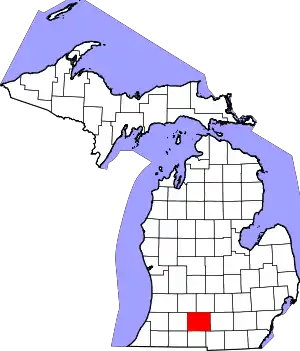Marshall, Michigan | |
|---|---|
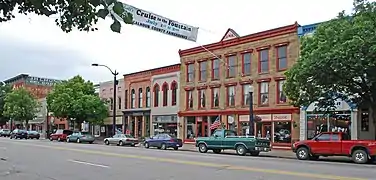 Downtown Marshall | |
 Location of Marshall, Michigan | |
| Coordinates: 42°16′14″N 84°57′36″W / 42.27056°N 84.96000°W | |
| Country | United States |
| State | Michigan |
| County | Calhoun |
| Incorporated | 1836 (village) 1849 (city) |
| Government | |
| • Mayor | James Schwartz[1] |
| Area | |
| • Total | 6.61 sq mi (17.12 km2) |
| • Land | 6.49 sq mi (16.82 km2) |
| • Water | 0.12 sq mi (0.30 km2) |
| Elevation | 919 ft (280 m) |
| Population (2020) | |
| • Total | 6,822 |
| • Density | 1,050.67/sq mi (405.66/km2) |
| Time zone | UTC-5 (Eastern (EST)) |
| • Summer (DST) | UTC-4 (EDT) |
| ZIP codes | 49068-49069 |
| Area code | 269 |
| FIPS code | 26-51940[3] |
| GNIS feature ID | 631630[4] |
| Website | cityofmarshall.com |
Marshall is a city and the county seat of Calhoun County, Michigan.[5] The population was 6,822 at the 2020 census.
Marshall is best known for its cross-section of 19th- and early 20th-century architecture and as the future home of Ford Motor Company's BlueOval Battery Park. [6] It has been referred to by the keeper of the National Register of Historic Places as a "virtual textbook of 19th-Century American architecture." Its historic center is the Marshall Historic District, one of the nation's largest architecturally significant National Historic Landmark Districts. The Landmark has over 850 buildings, including the world-famous Honolulu House.
History
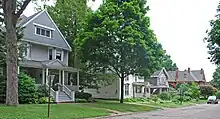
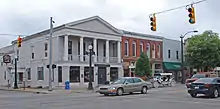
The town was founded by Sidney Ketchum (1797-1862) in 1830,[7] a land surveyor born in Clinton County, New York, in conjunction with his brother, George Ketchum (1794-1853). The Ketchum brothers explored central lower Michigan in 1830, and in late 1830, Sidney Ketchum obtained government grants for the land on which most of Marshall now stands. The early settlers named the community in honor of Chief Justice of the United States John Marshall from Virginia—whom they greatly admired. This occurred five years before Marshall's death and thus was the first of dozens of communities and counties named for him.[8] The village of Marshall was incorporated March 28, 1836.
Marshall was thought to be the frontrunner for state capital, so much so that a Governor's Mansion was built, but the town lost by one vote to Lansing. In the years thereafter, Marshall became known for its patent medicine industry until the Pure Drug Act of 1906. Marshall was involved in the Underground Railroad. When escaped slave Adam Crosswhite fled Kentucky and settled in Marshall with his wife and three children, the people of the town hid him from the posse sent to retrieve him. Those involved were tried in Federal Court and found guilty of denying a man his rightful property. This case and others like it caused the Fugitive Slave Act of 1850 to be pushed through Congress.
Two Marshall citizens Rev. John D. Pierce and lawyer Isaac E. Crary, innovated the Michigan school system and established it as part of the state constitution. Their method and format were later adopted by all the states in the old Northwest Territory and became the foundation for the Morrill Land-Grant Act in 1862, which established schools like Michigan State University all over the country. Pierce became the country's first state superintendent of public instruction and Crary Michigan's first member of the U.S. House.[8]
The first railroad labor union in the U.S., The Brotherhood of the Footboard (later renamed the Brotherhood of Locomotive Engineers and Trainmen), was formed in Marshall in 1863. Marshall was one of the only stops between Chicago and Detroit and became known as the Chicken Pie city because the only thing one could get to eat in the time it took to cool and switch engines was a chicken pie. A replica of the city's roundhouse can be seen at the Greenfield Village outdoor living history museum in Dearborn, Michigan.
In July 2010, an oil pipeline, owned by Enbridge Energy, ruptured, spilling over 850,000 gallons of crude oil into Talmadge Creek and into the Kalamazoo River. The event received national attention as it was, at that time, the largest oil spill in the inside the United States. The event was known as the Kalamazoo River Oil Spill.
In 2012, the U.S. National Transportation Safety Board stated the Enbridge oil spill in the Kalamazoo River near Marshall was the costliest onshore cleanup in U.S. history.[9]
In September of 2022, the Marshall Area Economic Development Alliance (MAEDA) and the Michigan Economic Development Corporation began promoting the "Marshall Megasite" to industrial manufacturers. At the time The Mega Industrial Park encompassing 1,600 acre tract of rural land (owned by separate landowners) located in Marshall Township just outside Marshall's city limits.[10] The move was controversial as the land was not yet zoned for heavy industry with the majority, over 1000 acres was zoned agricultural.
Marshall Township Residents were alerted that a large industrial project was to take place in their community via the announcement of PA 425 Land Transfers to take place in January 2023. There was widespread public opposition to the land transfers, which would take 1,900 acres off of the Marshall Township Tax rolls and put them on the City of Marshall Tax rolls. The transfer enabled the megasite to have access to city utilities such as water and electricity. The Marshall Township Board of Supervisors voted 4 to 1 for the PA 425 land transfers. The Marshall City Council voted for the transfer as well, although there was significant public opposition to the project. [11][12] [13] [14]
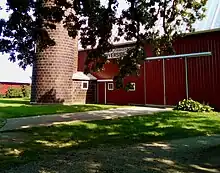
In February 2023, Governor Gretchen Whitmer and Ford Motor Company announced the Marshall Megasite would become the site of Ford BlueOval Battery Park.[15] The zoning changes on the property to allow for heavy industry were not made until May 1, 2023 by the Marshall City Council.[16] Residents filed a petition for referendum on the zoning and their petition was rejected by the Marshall City Clerk and the Marshall City Council Members. A lawsuit was filed against the City by the ballot committee named "Committee for Marshall-Not the Megasite" [17] This committee was countersued by a committee with ties to Governor Whitmer's campaign committee. [18]
Stand against slavery
In 1843, Adam Crosswhite,[19] his wife Sarah and their four children ran away from Francis Giltner's plantation in Hunter's Bottom, Carroll County, Kentucky because the Crosswhites learned that one of their four children was to be sold.[20] The Crosswhites made the tough journey north through Indiana along the Underground Railroad, beginning in Madison, Indiana. They finally settled in Marshall, where they were accepted, and Adam worked and built a cabin.[19]
In response to increasing numbers of runaway slaves, a coalition of slave owners in the north central counties and the Bluegrass region of Kentucky organized to recover the runaways. In January 1846, Francis Giltner's son David Giltner and three others went to Marshall to capture the Crosswhite family.[19]
On the morning of January 26, 1847, as the slave catchers and a local deputy sheriff were pounding on Adam's door, his neighbors heard the noise and came running. The cry of "slave catchers!" was yelled through the streets of Marshall. Soon, over 100 people surrounded the Crosswhite home.
Threats were shouted back and forth. One of the slave catchers began to demand that people in the crowd give him their names. They were proud to tell him and even told him the correct spelling. Each name was written down in a little book. Finally, the deputy sheriff, swayed by the crowd's opinion, decided he should arrest the men from Kentucky instead. Marshall townspeople hid the Crosswhites in the attic of George Ingersoll's mill. By the time the slave catchers could post bond and get out of jail, Isaac Jacobs, the hostler at the Marshall House, had hired a covered wagon and driven the Crosswhites to Jackson where they boarded a train to Detroit and then crossed over into Canada.[19]
The Giltners sued some of the people from Marshall for damages in what is known in federal records as the Giltner v. Gorham case'. It was tried in the federal court in Detroit. The Giltner v Gorham case resulted in two trials in federal court in Detroit, the first trial ending in a hung jury. At the conclusion of the second trial, the sole remaining defendant in the case, local banker Charles T. Gorham, was ordered to pay the value of the slaves plus court costs.[21] To curry political favor, Detroit entrepreneur Zachariah Chandler supposedly stepped in to pay these costs on Gorham's behalf.[22]
Because of the Crosswhite Affair and many others like it, Sen. Henry Clay from Kentucky pushed a new law through Congress in 1850 known as the Fugitive Slave Law, which made it very risky for anyone to help an escaped slave.[23]
Geography
According to the United States Census Bureau, the city has a total area of 6.40 square miles (16.58 km2), of which 6.28 square miles (16.27 km2) is land and 0.12 square miles (0.31 km2) is water.[24]
Demographics
| Census | Pop. | Note | %± |
|---|---|---|---|
| 1850 | 1,972 | — | |
| 1870 | 4,925 | — | |
| 1880 | 3,795 | −22.9% | |
| 1890 | 3,968 | 4.6% | |
| 1900 | 4,370 | 10.1% | |
| 1910 | 4,236 | −3.1% | |
| 1920 | 4,270 | 0.8% | |
| 1930 | 5,019 | 17.5% | |
| 1940 | 5,253 | 4.7% | |
| 1950 | 5,777 | 10.0% | |
| 1960 | 6,736 | 16.6% | |
| 1970 | 7,253 | 7.7% | |
| 1980 | 7,201 | −0.7% | |
| 1990 | 6,891 | −4.3% | |
| 2000 | 7,459 | 8.2% | |
| 2010 | 7,088 | −5.0% | |
| 2020 | 6,822 | −3.8% | |
| Source: Census Bureau. Census 1960- 2000, 2010. | |||
Marshall is part of the Battle Creek, Michigan Metropolitan Statistical Area.
2010 census
As of the census[25] of 2010, there were 7,088 people, 3,092 households, and 1,840 families residing in the city. The population density was 1,128.7 inhabitants per square mile (435.8/km2). There were 3,394 housing units at an average density of 540.4 per square mile (208.6/km2). The racial makeup of the city was 95.1% White, 1.1% African American, 0.6% Native American, 0.7% Asian, 0.7% from other races, and 1.8% from two or more races. Hispanic or Latino of any race were 3.8% of the population.
There were 3,092 households, of which 30.0% had children under the age of 18 living with them, 43.2% were married couples living together, 11.9% had a female householder with no husband present, 4.5% had a male householder with no wife present, and 40.5% were non-families. 34.9% of all households were made up of individuals, and 15.8% had someone living alone who was 65 years of age or older. The average household size was 2.25 and the average family size was 2.90.
The median age in the city was 40.5 years. 24% of residents were under the age of 18; 7.8% were between the ages of 18 and 24; 23.8% were from 25 to 44; 26.3% were from 45 to 64; and 18.2% were 65 years of age or older. The gender makeup of the city was 47.5% male and 52.5% female.
2000 census
As of the census[3] of 2000, there were 7,459 people, 3,111 households, and 1,935 families residing in the city. The population density was 1,260.7 inhabitants per square mile (486.8/km2). There were 3,353 housing units at an average density of 566.7 per square mile (218.8/km2). The racial makeup of the city was 95.91% White, 0.32% African American, 0.43% Native American, 0.59% Asian, 0.99% from other races, and 1.76% from two or more races. Hispanic or Latino of any race were 3.16% of the population.
There were 3,111 households, out of which 30.9% had children under the age of 18 living with them, 48.5% were married couples living together, 10.0% had a female householder with no husband present, and 37.8% were non-families. 32.9% of all households were made up of individuals, and 15.0% had someone living alone who was 65 years of age or older. The average household size was 2.33 and the average family size was 2.98.
In the city, the population was spread out, with 25.0% under the age of 18, 7.3% from 18 to 24, 28.2% from 25 to 44, 21.2% from 45 to 64, and 18.3% who were 65 years of age or older. The median age was 38 years. For every 100 females, there were 86.0 males. For every 100 females age 18 and over, there were 81.2 males.
The median income for a household in the city was $41,171, and the median income for a family was $53,317. Males had a median income of $41,446 versus $30,398 for females. The per capita income for the city was $22,101. About 2.6% of families and 5.0% of the population were below the poverty line, including 3.2% of those under age 18 and 3.9% of those age 65 or over.
Festivals
- The Calhoun County Fair is the oldest operating County Fair in Michigan. Operated by the Calhoun County Agricultural and Industrial Society, the fair takes place during the second week in August. Floral Hall, located on the grounds is the oldest fair building in the state. Marshall maintains its strong agricultural ties with a large number of students involved in FFA and 4-H.
- The Marshall Historic Home Tour, the oldest historic home tour in the Great Lakes area, is held annually the weekend after Labor Day. The tour features eight private historic homes, a church, a business, and eight museums open for the two days of the tour. There is also musical entertainment, a juried craft show, and a Civil War Ball with elaborate costumes on Saturday night. The tour, now in its 50th year, is presented by the Marshall Historical Society.
- Cruise to the Fountain features about 1,000 classic cars from the 1950s and 1960s the weekend before the Fourth of July at the Calhoun County Fairgrounds. On Friday and Saturday nights the cars cruise from the Fairgrounds through the downtown, around the Brooks Memorial Fountain and back.
- Blues Fest is held each June, with blues musicians from all over the Midwest performing downtown, complete with food vendors and a beer tent.
- Skeleton Fest held the last Saturday in September, over 30 whimsically posed skeletons take over the downtown area. There is a free, family-friendly kick-off party for the kids, followed by a Pub & Grub crawl for the adults.
- The Monday after Thanksgiving is the date of the annual Christmas Parade. There are typically over 100 entries for this parade. It averages 6–10 bands and 20-40 floats. Santa's arrival to Marshall is always the highlight of this event.
- Marshall Historical Society's Christmas Candlelight Walk features five private homes on tour in a small group setting. Limited tickets are sold for Saturday and Sunday afternoon and evening walks. The Walk, now in its 40th year, is held annually in early December.
- On the second weekend in June and first weekend in October, the Fiber Arts & Animals Festival is held. This festival has been held since 2005.[26]
Transportation
Major highways
 I-69, a north–south freeway connecting with Fort Wayne, Indiana, to the south and Lansing to the north.
I-69, a north–south freeway connecting with Fort Wayne, Indiana, to the south and Lansing to the north. I-94, an east–west route connecting with Battle Creek and Kalamazoo on the west and Jackson and Detroit on the east.
I-94, an east–west route connecting with Battle Creek and Kalamazoo on the west and Jackson and Detroit on the east. BL I-94 runs through downtown.
BL I-94 runs through downtown. M-96 runs westerly from Marshall through Battle Creek and on to Kalamazoo.
M-96 runs westerly from Marshall through Battle Creek and on to Kalamazoo. M-227 has as its northern terminus at BL I-94 (Michigan Avenue) on the west side of Marshall, near I-69.
M-227 has as its northern terminus at BL I-94 (Michigan Avenue) on the west side of Marshall, near I-69.
Public Transportation
- The city of Marshall provides Demand responsive transport bus service during the week with no service provided on weekends or major holidays.[27]
- Amtrak, the national passenger rail system, provides daily service to nearby Battle Creek, Michigan and Albion, Michigan, operating its Wolverine both directions between Chicago, Illinois and Pontiac, Michigan, via Detroit.
Airport
Brooks Field is a non-towered General Aviation airfield owned and operated by the city of Marshall. The airport features a single runway (10/28) 3500 x 75 feet, helipad, public and private hangars, lighted wind indicator, segmented circle, compass rose, and a tie down apron.
Notable people
- Gwen Robinson Awsumb, mid-20th century politician and social activist
- John Bellairs, fantasy author best known for The House with a Clock in Its Walls
- Cyrus W. Cole, highly decorated U.S. Navy officer with the rank of Rear Admiral
- Ryan A. Conklin, author and castmember of Real World: Brooklyn and Return To Duty
- Adam Gase, former head coach of the New York Jets, and the Miami Dolphins
- Homer Hazel, all-American college football player
- Jamie Hyneman, co-host of the TV series MythBusters
- Belle K. Maniates, novelist and short story writer
- Sharon Miller, professional golfer and winner of two LPGA Tour tournaments
- John Morse, professional golfer
- Sam Hill, American surveyor with legendary profanity
Notable businesses
- Dark Horse Brewery
- Honolulu House
- Oaklawn (Hospital & Medical Group) - currently the city's largest employer
- The last Kmart in the state of Michigan (which closed November 21, 2021)
- Ford Blue Oval Battery Park Michigan (Predicted to Open in 2026)
Museums and historical markers
- The second-largest U.S. Postal Service museum is in Marshall. Its 4,000 artifacts—including uniforms, rural carrier memorabilia, rural post office equipment, automobiles and sleds—are eclipsed only by the collection of the Smithsonian Institution Smithsonian National Postal Museum in Washington D.C. It was established in 1986, and is in the basement of the historical Schragg Marshall post office (named after Michael Schragg, a former postmaster)[28] See U.S. Postal Museums.
There are many recognized Michigan historical markers in Marshall,[29] including
- Adam Crosswhite[30]
- American Museum of Magic
- Butler-Boyce House / W. D. Boyce
- Calhoun County Fair
- Capitol Hill School
- Charles T. Gorham
- First Baptist Church (Marshall)
- Governor's Mansion
- Grand Army of the Republic / The G. A. R. Hall
- Harold C. Brooks / Fitch Gorham Brooks House
- Hillside / Mary Miller
- Honolulu House
- Isaac Crary and John Pierce / State School System
- Isaac E. Crary House
- James A. Miner
- Jeremiah Cronin. Jr. House / John Bellairs
- John D. Pierce Homesite
- Ketchum Park
- Lieutenant George A. Woodruff
- Lockwood House / Lockwood Family
- Marshall Historic District
- Marshall Avenue Bridge
- National House
- The Old Stone Barn
- Oliver C. Comstock Jr.
- Pioneer School
- Postmasters / Howard F Young
- Railroad Union Birthplace
- Sam Hill House
- Samuel Coleman House
- Schellenberger Tavern
- Schuler's
- Sidney Ketchum / Marshall House
- Thomas J. O'Brien
- Trinity Episcopal Church / Montgomery Schuyler
- William W. Cook
References
- ↑ "City of Marshall Website". Retrieved 2019-01-24.
- ↑ "2020 U.S. Gazetteer Files". United States Census Bureau. Retrieved May 21, 2022.
- 1 2 "U.S. Census website". United States Census Bureau. Retrieved 2008-01-31.
- ↑ "US Board on Geographic Names". United States Geological Survey. 2007-10-25. Retrieved 2008-01-31.
- ↑ "Find a County". National Association of Counties. Retrieved 2011-06-07.
- ↑ "The Detroit News". www.detroitnews.com. Retrieved 2023-11-27.
- ↑ Pardoe, Debbie; Collins, Susan (2008). Marshall. Charleston SC, Chicago IL, Portsmouth NH, San Francisco, CA: Arcadia Publishing. ISBN 9780738552347. Retrieved 22 Jun 2020.
{{cite book}}:|website=ignored (help) - 1 2 City of Marshall, Michigan
- ↑ "Enbridge to Spend Up to $500 Million More on Northern Gateway Safety". Fox Business. Retrieved 2012-07-22.
- ↑ "'Marshall Megasite' garners interest from manufacturing companies". WOODTV.com. 2022-09-08. Retrieved 2023-01-08.
- ↑ Megasite - Township Residents speak against Ford's BlueOval Battery Park at Public Hearing pt1, retrieved 2023-11-27
- ↑ "'We've built our life here': Marshall-area residents voice concerns about megasite development". Battle Creek Enquirer. Retrieved 2023-11-27.
- ↑ Residents push back on proposed ‘Marshall Megasite’, retrieved 2023-11-27
- ↑ "Marshall Township Residents Speak Against the Marshall Megasite". Stop the Marshall Michigan Megasite!. Retrieved 2023-11-27.
- ↑ "Whitmer celebrates new Ford battery plant in Michigan backed by state support valued over $1B". Detroit Free Press. Retrieved 2023-11-27.
- ↑ Channel 3, News (2023-05-01). "Marshall City Council rezones land for Ford's electric vehicle battery plant". WWMT. Retrieved 2023-11-27.
{{cite web}}:|first=has generic name (help)CS1 maint: numeric names: authors list (link) - ↑ "Opponents sue to stop Marshall Megasite". WOODTV.com. 2023-06-27. Retrieved 2023-11-27.
- ↑ "Detroit Free Press". www.freep.com. Retrieved 2023-11-27.
- 1 2 3 4 Smith, G.L.; McDaniel, K.C.; Hardin, J.A. (2015). The Kentucky African American Encyclopedia. University Press of Kentucky. p. 128. ISBN 978-0-8131-6066-5. Retrieved 25 Jun 2020.
- ↑ "160 years ago, Marshall residents united to save a family from slave catchers". Michigan Radio. 13 Jun 2018. Retrieved 23 Jun 2020.
- ↑ "GILTNER V. GORHAM ET AL. Case No. 5,453" (PDF). law.resource.org. 1848. Archived (PDF) from the original on 2020-06-25. Retrieved 23 Jun 2020.
- ↑ Clark, Sandra; Michigan Center (June 13, 2018). "160 years ago, Marshall residents united to save a family from slave catchers". www.michiganradio.org. Retrieved 2021-03-25.
- ↑ Chardavoyne, David G. (November 2004). "Michigan and the Fugitive Slave Acts" (PDF). The Court Legacy. Vol. XII, no. 3. The Historical Society for the United States District Court for the Eastern District of Michigan. Archived from the original (PDF) on 2006-09-23. Retrieved 2007-06-28.
- ↑ "US Gazetteer files 2010". United States Census Bureau. Archived from the original on 2012-07-02. Retrieved 2012-11-25.
- ↑ "U.S. Census website". United States Census Bureau. Retrieved 2012-11-25.
- ↑ "Our Story". Fiber Arts & Animals Festival. Archived from the original on 2009-02-11. Retrieved 2008-03-13.
- ↑ "Dial-a-Ride and The Albion-Marshall Connector". cityofmarshall.com. City of Marshall, Michigan. Retrieved August 29, 2017.
- ↑ Meyer, Zlati (March 20, 2011). "You haven't lived here until ... You snail-mail yourself to the Marshall postal museum". Detroit Free Press. p. 20. Retrieved March 20, 2011.
- ↑ "Michigan Historical Markers". michmarkers.com. Archived from the original on 2010-03-15. Retrieved 2010-02-01.
- ↑ "Cabin of Adam Crosswhite Historical Marker". www.hmdb.org. Retrieved 2022-03-18.
